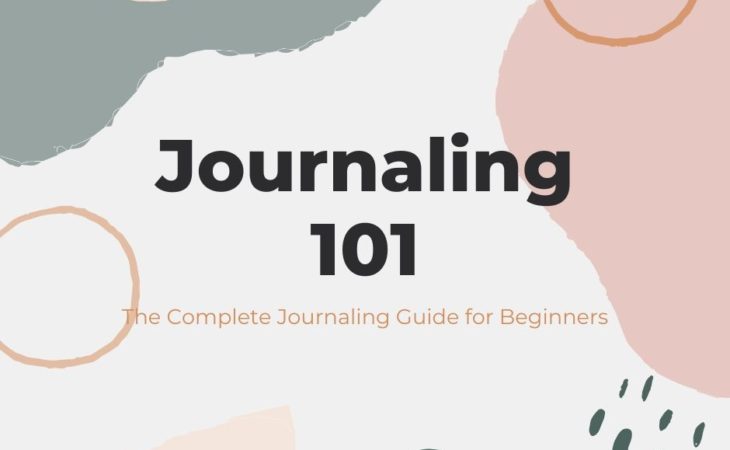Keeping a journaling habit can be tricky…
When we think of writing in a journal or diary, it doesn’t seem like it’d be something difficult to do.
I mean, journaling is simply the act of writing one’s thoughts, right? And as long as you know how to write and can express a coherent thought, then chances are, journaling is worth a shot.
But while journaling itself isn’t too complex, consistently journaling and making it a daily habit can be more difficult than you might think.
In this complete guide to journaling, we’ll cover the following topics:
- What is Journaling?
- Types of Journaling
- Benefits of Journaling
- How to journal
- How to keep a journal consistently
What is Journaling?
Journaling is a type of writing where you record your thoughts, expressions, and feelings about a particular topic or situation.
The act of journaling itself is writing in a journal, but there are several different types of journal writing that you can utilize.
Journaling differs from simply writing because it is intentionally used to write in a self-reflective style. The writer often looks inward for content and material to journal about.
Types of Journaling
Because journaling is a broad category, there are several different types of journaling that appeal to different people based on personality, background, and skill.
While I love the idea of art journaling or even bullet journaling (I love looking at pretty things), I don’t have the artistic talent or skill to create something that would keep me engaged.
Some people don’t like writing, and are more visual – so they use unlined blank journals to create sketches and collages.
Regardless of which type of journaling you’re drawn to, it’s common to find that all journals reflect the writer’s life experiences and often have to do with subjects or topics that center on the person journaling.
Because there are quite a few benefits of journaling, the practice has been adopted as a form of art therapy, and different creative deviations from the traditional journal practice have sprouted up.
Here are the common types of journaling:
#1 – Daily Journal
A daily journal is used for daily journaling, often used to record daily thoughts, feelings, and/or experiences. Many people use a daily journal as part of their daily routine. For example, I write in a quick paragraph or two (at the least) in my daily journal every morning before I get my day started.
Daily Journals: Pros
- Easy-to-use. A daily journal can be as simple as you want it to be! There really are no rules, which makes this a user-friendly option for anyone looking to up their journaling game.
- No prep needed. If you just want to record your daily thoughts, experiences, and activities, then there’s really nothing you need to prep beforehand and it’s pretty low maintenance.
- Versatile. A daily journal can be used in a variety of different ways – whether you want to write in response to specific journaling prompts, freehand journal, or doodle, it’s up to you.
Daily Journal: Cons
- Can be hard to stick to for those who don’t make it a habit. We forget to journal on a daily basis, and if you’re new to journaling, it can be difficult for the habit to stick to at first. Consistence is key!
- Usually not ideal for visual elements. For those that like to sketch and doodle, daily journals are typically set up to be your standard lined paper. But, you can always use an unlined daily journal if you like to write and draw.
- Can be creatively-limiting depending on your topics. Most people approach the daily journal with the mindset that they have to record all the day’s events, like a diary. This isn’t so, and can actually be self-limiting!
#2 – Art Journal
An art journal is typically filled with unlined, blank pages to provide a blank canvas for drawing, sketches, collages, and other visual elements. Art journaling is actually a big practice in some mental health practices due to the benefits of art therapy.
Art Journal: Pros
- Visually appealing. Art is pretty or interesting to look at, so it makes sense that a journal dedicated to art is more engaging to look at than a traditional lined journal full of words.
- Provides art therapy. Art journaling is a highly creative medium, which means it can be very therapeutic.
Art Journal: Cons
- Can be difficult for those not artistically inclined. While it’s not necessary that you need to be a killer artist to keep an art journal, it can be frustrating to keep an art journal if being artsy doesn’t come easy for you.
- Additional materials. While you don’t need any fancy tools to draw, sketch, or doodle, if you have a specific vision for your art journal, you might need more than just pencil and paper. Think of colored pens and pencils, stencils, stickers, and more.
#3 – Bullet Journal
An analog system created by Ryder Carroll, the bullet journal combines elements of both a planner and journal style. The pages are dotted,
#4 – Travel Journal
Use a travel journal to document your experiences while traveling. Maybe you want to create a visual spread with itineraries and ticket stubs, or maybe you want to write descriptive day-by-day accounts of your journey. Or maybe you want to do a mix of the two. The possibilities are endless with travel journaling!
#5 – Dream Journal
Most of us wake up after extremely vivid dream experiences, only to forget them within the first half hour of waking. If you’re someone who is open to dream analysis, or simply wants to keep track of your mental activity whilst you’re asleep, a dream journal or sleep diary is a good option for you.
#6 – Gratitude Journal
Showing gratitude and being thankful is the key to happiness, or so they say. If you’re really trying to make an effort to be more thankful for your life and all the blessings in it, or increase your performance and overall mindset, try keeping a gratitude journal where you can think consciously about the things you are grateful for, and record them. Looking back at all the things you’re thankful for will help you appreciate life more.
#7 – Junk Journal
Although the name doesn’t sound too appealing, you should think of junk journals as a pot of gold, especially if you’re someone who loves all things vintage and enjoys the thrill of hunting for treasure at thrift stores and antique shops. A junk journal is a handmade journal or collage filled with handmade paper products like doilies, postal cards, music sheets, patterned paper, lace, and more. There are plenty of enthusiasts in the junk journal niche – and you can even buy ready-made ones on handmade sites like Etsy. However, I recommend making your own if you’re intent is to truly try “journaling.”
#8 – Reading Journal
Calling all bibliophiles! This type of journal is a bookish person’s dream, especially if you love collecting quotes and capturing words from a book that moved you. Basically, you can use a book or reading journal to keep track of and rate books you’ve read, house all your TBR lists, or jot down important concepts or quotes from books your currently reading.
#9 – Brainstorm Journal
If you’re a multi-potentialite like me with a million and one new ideas that pop into your head everyday, you might consider a brainstorm journal. It’s a journal where you can record any random idea, thought, or brainstorming concept that you think of and want to revisit later. I currently record my ideas in many different mediums – on my Notes iPhone app, on my whiteboard in my office, in various documents and notebooks. Maybe it’s time I start my own dedicated brainstorm journal?
#10 – Health Journal
This type of journal can be broad as well. You can use a health journal as a food diary, fitness tracker, or for certain things like pregnancy or menstrual cycles. Having certain health data all in one place for you to record and review daily is helpful in developing new habits and analyzing certain conditions.
Benefits of Journaling
There are quite a few benefits of journaling, and we cover this in-depth in another article, but here’s a recap.
- Creativity
- Self-Expression
- Thought Process
- Introspection
How to Journal
Step 1: Choose why you want to journal
Step 2: Think of your strengths
Step 3: Find a type of journal that fits you
Step 4: Get journaling supplies
Step 5: Journal regularly to make it a habit
Step 6: Be intentional when you journal
Step 7: Make it your own
Step 8: Reflect periodically
How to Keep a Journal Consistently
We all love the idea of journaling, especially when we do it a few times and experience the benefits first-hand.
Journaling has a way of lightening our load…of making us feel heard in a world of incessant noise that drowns out our own voice.
So why is it so hard to journal consistently?
Sticking to your journaling practice is a struggle for most people, myself included. We do it a few times, then suddenly stop and forget about it…then we pick it back up again only to stop yet again. It seems like a never-ending cycle.
While I don’t currently have the magic answer to consistent journaling, I do have some tidbits to share on how you can start being more intentional, and consistent, with your journaling practice.
Here’s how to consistently write in your journal:
- Schedule it in. Whether you want to write daily, weekly, or monthly, an effective way to remind yourself to journal is to actually schedule it in. If you use a planner, pencil it in! If you use calendar notifications, pencil it in!
- Set reminders. However your brain works best when it comes to reminders, apply the same technique to journaling. Set an alert on your phone, or tape a sticky note somewhere visible, where you can see it (like near your desk, bathroom, or nightstand).
- Create goals. These don’t have to be ambitious goals; in fact, you should aim to keep your journaling goal realistic, so it can organically fit into your normal schedule. I do best when I set a weekly goal to journal at least 3 time a week. Then, I structure my days out to schedule a journal session at least 3 times in the week. If I have to skip a day, that’s okay – I can always make up for it the next day.
- Be relaxed. Don’t stress about this or add too much pressure on yourself; journaling should be as relaxing of a practice as possible! Try not to have an “all or nothing” approach. If you fall off your journaling routine, just keep starting.
- Have a flexible word count. While you may start out wanting to write a full page entry in your journal, there will be days when you don’t want to to write two words. Find a middle ground, and don’t force it. Be okay with writing a sentence or two, if that’s all that you can muster out.
- Create a routine. Get yourself in the journaling mood by intentionally creating a mood. Light a candle, grab some tea, and sit in your favorite chair before you begin journaling. Or, go simple and write the moment you lay down in bed for the night. Setting a routine will help trigger your body and set your mood for writing.
- Consider your journal’s placement. Keep your journal in the same spot every day so you never forget where it is, or keep it with you at all times if you write best in-the-moment. While I’d love to keep my journal on me at all times, I’m too forgetful for that. Instead, I keep it on my bedside.
Journal Writing Prompts
What are some of your favorite journal writing prompts?



